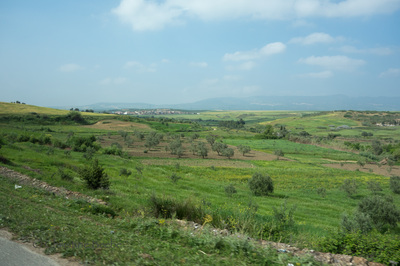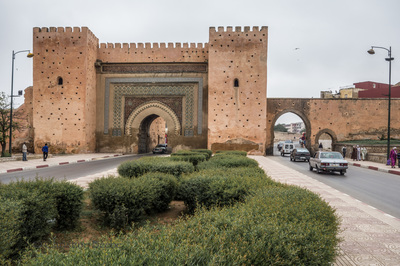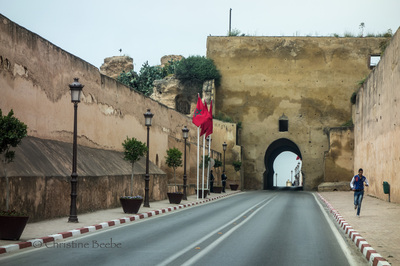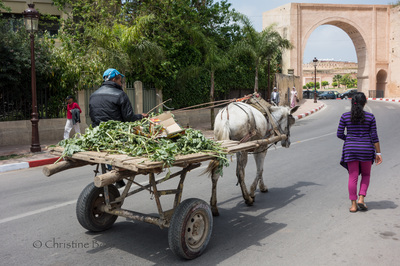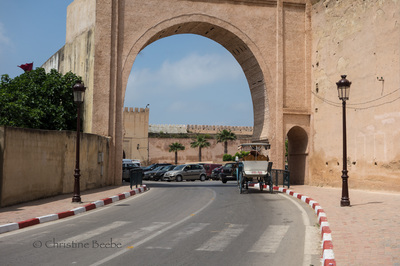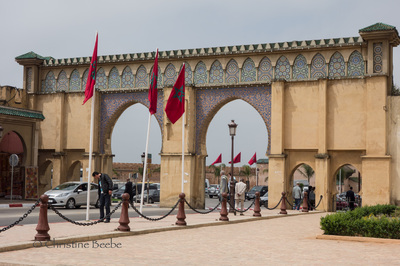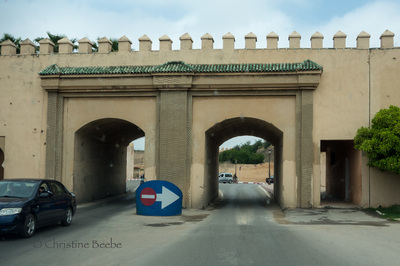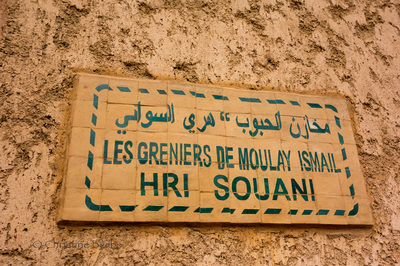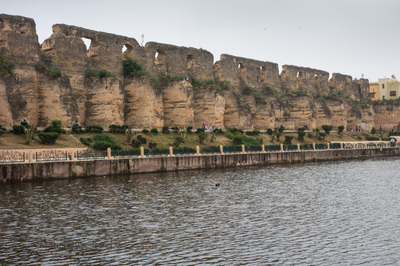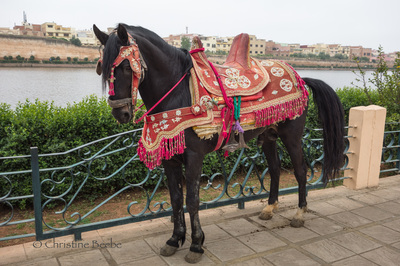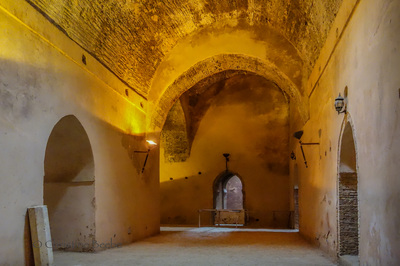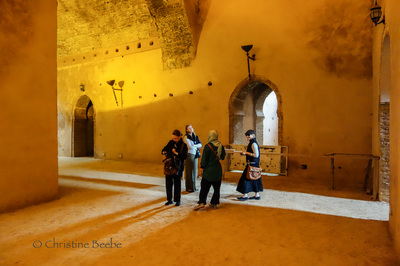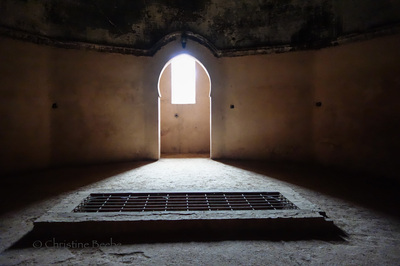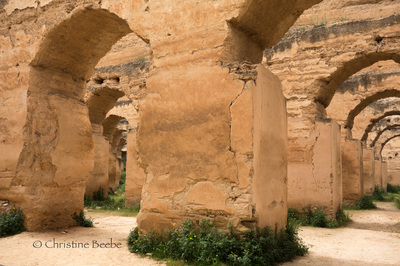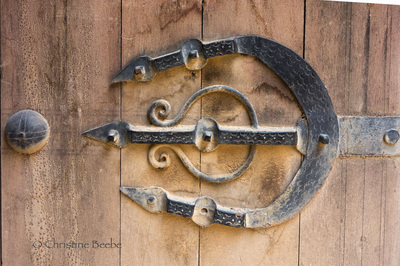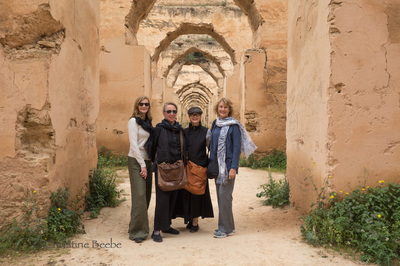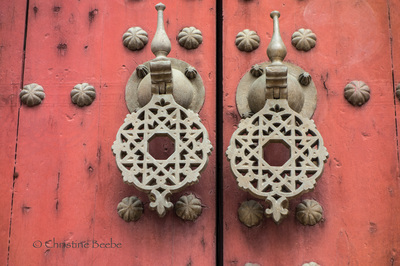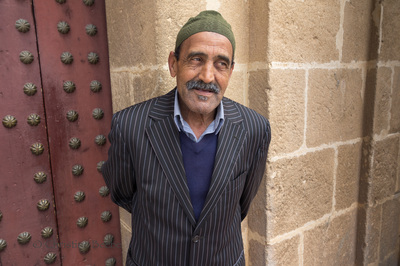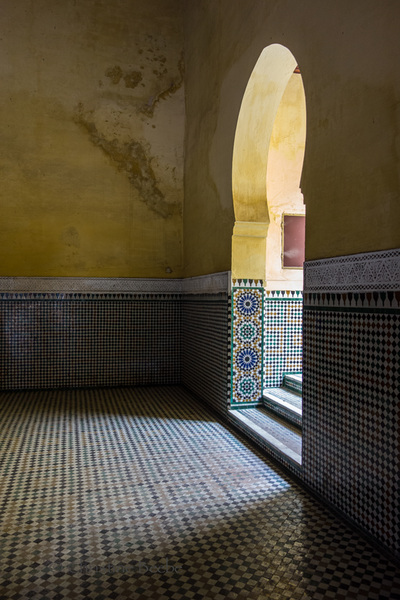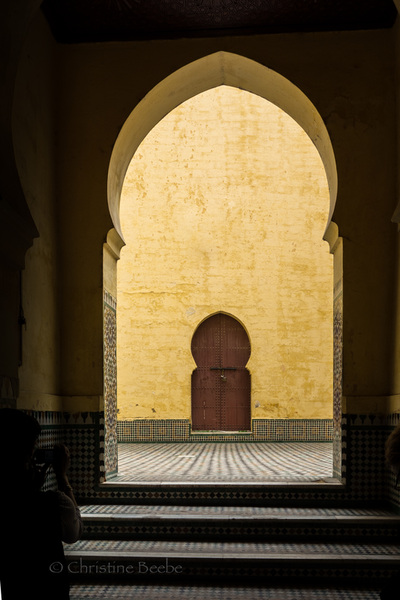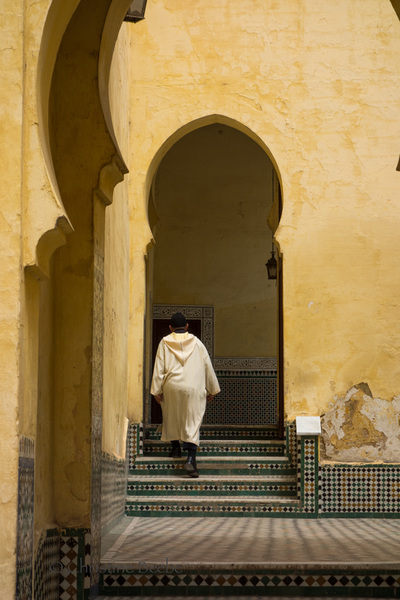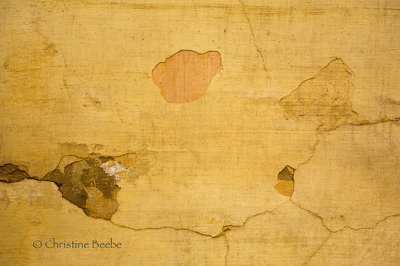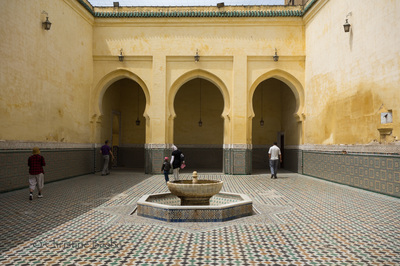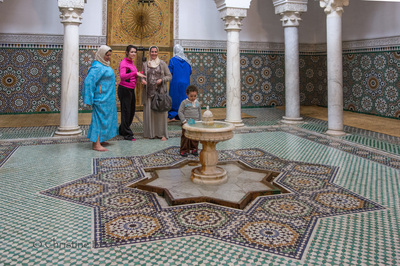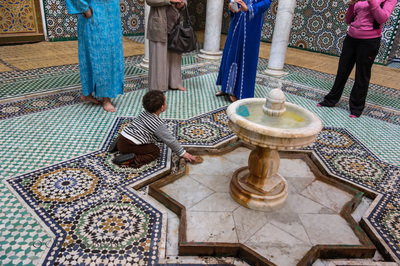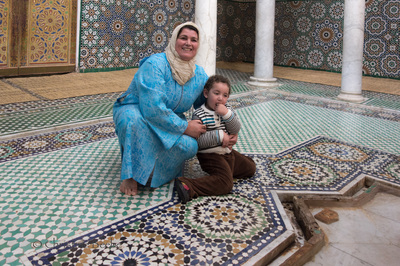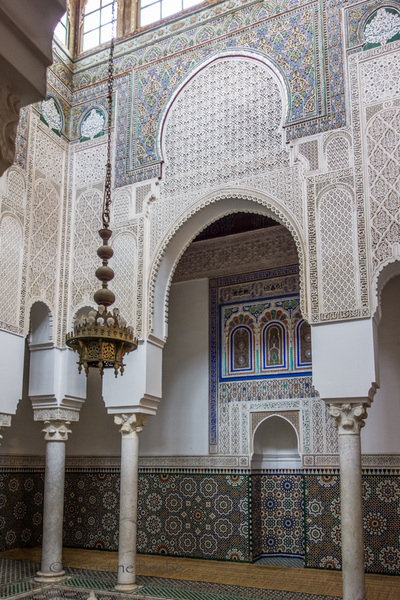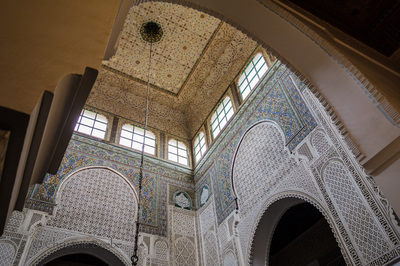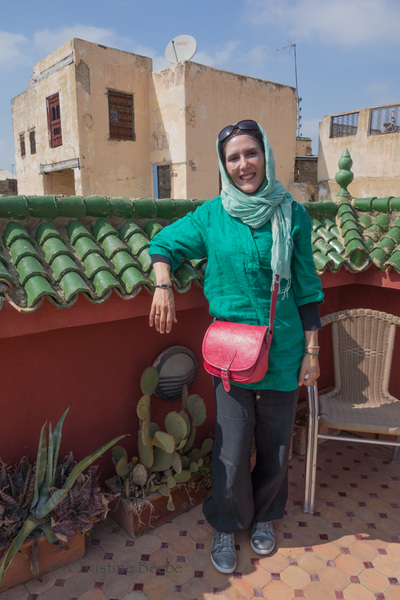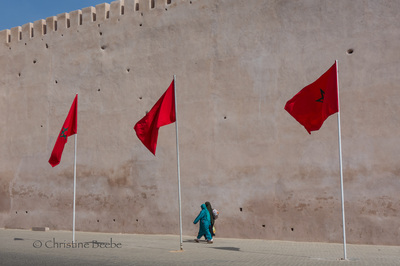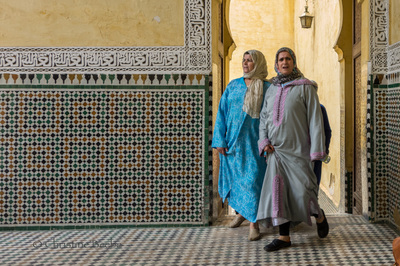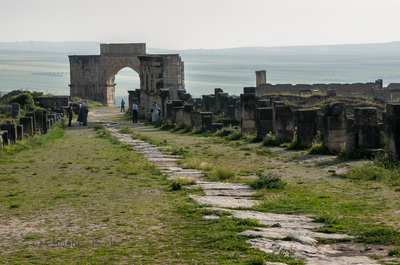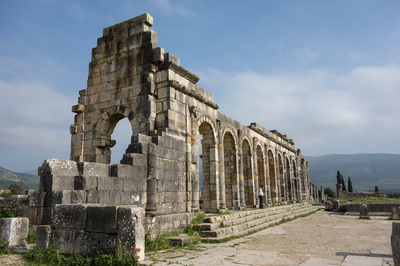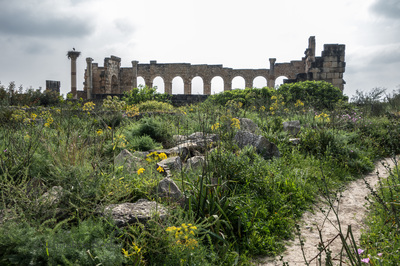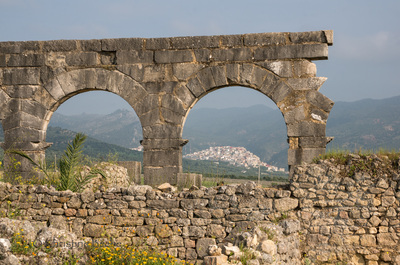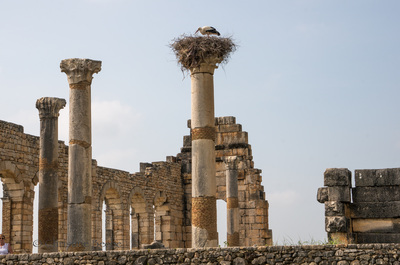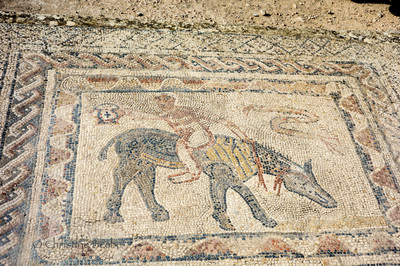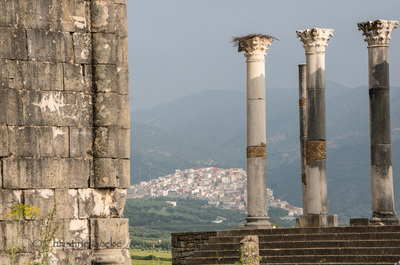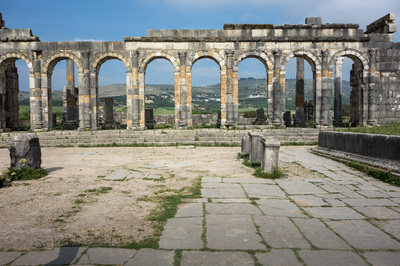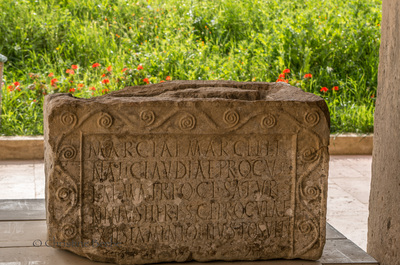Today we drove through rolling green countryside past olive groves, grasses and wildflowers, to visit two cities near Fes: Meknes, the smallest of Morocco’s four Imperial Cities and capital of Morocco in the 1600’s, and the extensive Roman ruins at the ancient site of Volubilis, claimed by Marcus Aurelius in AD 168.
MEKNES
We entered Meknes through the grand triumphal arch called Bab Khemis, said to be the most beautiful of Morocco’s many arches. It’s also most welcoming with its Arabic inscription proclaiming: “I am the Happy Gate and I welcome all to pass, whether Muslim, Jew, or Christian.”
MEKNES
We entered Meknes through the grand triumphal arch called Bab Khemis, said to be the most beautiful of Morocco’s many arches. It’s also most welcoming with its Arabic inscription proclaiming: “I am the Happy Gate and I welcome all to pass, whether Muslim, Jew, or Christian.”
Meknes was founded by Sultan Moulay Ismail, a ruthless and powerful man descended from the Prophet Mohammed, who set the stage for modern Morocco by wrenching power from foreigners and rebellious Berber tribes. He celebrated his first day in power by murdering all those who refused to submit to his control, yet he was also responsible for Morocco’s last golden age, building an enormous and extravagant palace complex in Meknes, along with many miles of city walls, monumental gates, arches, and kasbahs.
Noted for his excesses, the sultan had a hundred wives and sired 867 children, widely considered to be the largest number of offspring attributed to one man in history.
For his beloved 12,000 Arabian horses, he built an immense stable and granary building, which housed and fed all of them. Massive stone walls, tiny windows, and an elaborate system of underground water channels kept the buildings cool in summer, while thousands of slaves stood at the ready to care for the horses’ every need. We walked under high vaulted stone ceilings in the restored section, then emerged to see long rows of expansive stone archways and stable walls, now crumbling with time and open to the sky, all lined up in perfect geometric order, seeming to stretch to infinity in accordance with the sultan’s wishes for excess and splendor.
Noted for his excesses, the sultan had a hundred wives and sired 867 children, widely considered to be the largest number of offspring attributed to one man in history.
For his beloved 12,000 Arabian horses, he built an immense stable and granary building, which housed and fed all of them. Massive stone walls, tiny windows, and an elaborate system of underground water channels kept the buildings cool in summer, while thousands of slaves stood at the ready to care for the horses’ every need. We walked under high vaulted stone ceilings in the restored section, then emerged to see long rows of expansive stone archways and stable walls, now crumbling with time and open to the sky, all lined up in perfect geometric order, seeming to stretch to infinity in accordance with the sultan’s wishes for excess and splendor.
We also visited the sultan’s mausoleum. His status as one of Morocco’s greatest rulers means that non-Muslims may enter the sanctuary, via a series of austere and peaceful courtyards meant to induce a quiet and humble attitude among visitors. The shadowplay of light on ochre-colored walls and intricate tilework as we passed through traditional Moroccan archways created a stunning effect. But the ambiance was less than respectful when we entered the inner courtyard, due to four giggling Moroccan woman taking cell phone photos of a young child who couldn’t keep his hands out of the fountain intended for ablations by those coming to worship.
Our Meknes guide “Atimath” was one of the few female guides we had in Morocco, and we learned a lot from her regarding what it’s like to be female in an Islamic country. She first emphasized that things have come a long way in recent years, and to dispel any misconceptions, she said: "Morocco is an Islamic country, not an Arabic country – and there’s a big difference. But I dream for more rights for woman some day.”
Men are still allowed to have up to 4 wives (although now the first must give permission) and husbands have the right to control them. Atimath told us about her college-educated sister who’d become engaged to a man who seemed to appreciate her for who she was but as soon as they were married, he demanded she quit her job and begin wearing a burka. The only way she could have the marriage annulled was by paying a judge the equivalent of $7,000 US, which she did. Atimath told us she herself has decided to not get married at all!
Many women here wear traditional "djellabas", loose fitting hooded garments that fall to the feet; this is especially true of older women and women outside the cities. Among those that choose to wear Western attire, most still wear a head scarf. Even teenage girls who wear skin-tight jeans and modern tops often still wear head scarfs, which are sometimes considered a fashion statement as much as a respect for tradition.
Men are still allowed to have up to 4 wives (although now the first must give permission) and husbands have the right to control them. Atimath told us about her college-educated sister who’d become engaged to a man who seemed to appreciate her for who she was but as soon as they were married, he demanded she quit her job and begin wearing a burka. The only way she could have the marriage annulled was by paying a judge the equivalent of $7,000 US, which she did. Atimath told us she herself has decided to not get married at all!
Many women here wear traditional "djellabas", loose fitting hooded garments that fall to the feet; this is especially true of older women and women outside the cities. Among those that choose to wear Western attire, most still wear a head scarf. Even teenage girls who wear skin-tight jeans and modern tops often still wear head scarfs, which are sometimes considered a fashion statement as much as a respect for tradition.
VOLUBILIS
Volubilis was a Roman settlement constructed atop an ancient Carthaginian city dating from the 3rd century B.C., and now represents some of the largest ancient ruins in Africa. Once home to over 20,000 people, Volubilis was a central administrative city for this part of Africa, responsible for the production of grain in this fertile region and the export of goods to Rome. Volubilis also traded with Berber tribes for mutual benefits.
People continued to live in Volubilis for more than 1,000 years after the Romans left, and the city was only abandoned in the 18th century when it was plundered to provide building materials for Sultan Moulay Ismail's palaces and gates in nearby Meknes. It was recognized by UNESCO in 1997 and is the best preserved archaeological site in Morocco.
Volubilis was a Roman settlement constructed atop an ancient Carthaginian city dating from the 3rd century B.C., and now represents some of the largest ancient ruins in Africa. Once home to over 20,000 people, Volubilis was a central administrative city for this part of Africa, responsible for the production of grain in this fertile region and the export of goods to Rome. Volubilis also traded with Berber tribes for mutual benefits.
People continued to live in Volubilis for more than 1,000 years after the Romans left, and the city was only abandoned in the 18th century when it was plundered to provide building materials for Sultan Moulay Ismail's palaces and gates in nearby Meknes. It was recognized by UNESCO in 1997 and is the best preserved archaeological site in Morocco.
